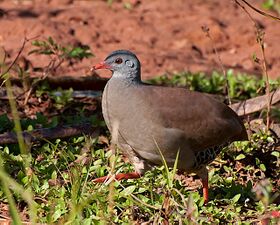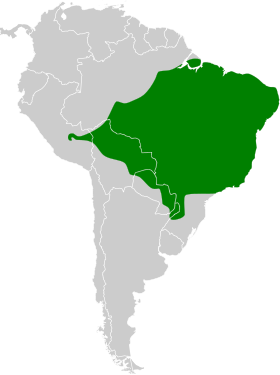تنام صغير المنقار
|
تنام صغير المنقار | |
|---|---|

| |
| حالة الحفظ | |
 أنواع غير مهددة أو خطر انقراض ضعيف جدا | |
| المرتبة التصنيفية | نوع[1] |
| التصنيف العلمي | |
| النطاق: | |
| المملكة: | |
| الشعبة: | حبليات Chordata
|
| الشعيبة: | فقاريات Vertebrata
|
| الطائفة: | طيور Aves
|
| الطويئفة: | طيور حديثة Neornithes
|
| الرتبة العليا: | تناميات الشكل Dromaeomorphae
|
| الرتبة: | تناميات Tinamiformes
|
| الفصيلة: | تنامية Tinamidae
|
| الأسرة: | تناماويات Tinaminae
|
| الجنس: | تنام مخفي الذيل Crypturellus
|
| النوع: | تنام صغير المنقار
|
| الاسم العلمي | |
| Crypturellus parvirostris [1] Wagler، 1827 | |

| |
| تعديل |
|
تنام صغير المنقار (الاسم العلمي:Crypturellus parvirostris) هو نوع من الطيور يتبع جنس التنام مخفي الذيل من فصيلة التنامية[2] [3] [4]
. . . . . . . . . . . . . . . . . . . . . . . . . . . . . . . . . . . . . . . . . . . . . . . . . . . . . . . . . . . . . . . . . . . . . . . . . . . . . . . . . . . . . . . . . . . . . . . . . . . . . . . . . . . . . . . . . . . . . . . . . . . . . . . . . . . . . . . . . . . . . . . . . . . . . . . . . . . . . . . . . . . . . . . .
Description
The small-billed tinamou is approximately 22 cm (8.7 in) in length. Its upperparts are dark brown, with grey to brownish under parts and head. Its bill and legs are red.
التصنيف
The small-billed tinamou is a monotypic species.[5] All tinamou are from the family Tinamidae, and in the larger scheme are also ratites. Unlike other ratites, tinamous can fly, although in general, they are not strong fliers. All ratites evolved from prehistoric flying birds, and tinamous are the closest living relative of these birds.[6]
أصل الاسم
Crypturellus is formed from three Latin or Greek words. kruptos meaning covered or hidden, oura meaning tail, and ellus meaning diminutive. Therefore, Crypturellus means small hidden tail.[7]
السلوك
Like other tinamous, the small-billed eats fruit off the ground or low-lying bushes. They also eat small amounts of invertebrates, flower buds, tender leaves, seeds, and roots. The male incubates the eggs which may come from as many as 4 different females, and then will raise them until they are ready to be on their own, usually 2–3 weeks. The nest is located on the ground in dense brush or between raised root buttresses.[6]
الاستئناس
The small billed tinamou has been considered an ideal candidate for domestication as the birds can raise 3-4 broods per year and are resistant to diseases that affect chickens
النطاق والموئل
The small-billed tinamou prefers dry savanna, but will also reside in lowland shrubland.[8] Its range is Amazonian South America; Brazil except for the southeastern portion, northeastern Peru, eastern Bolivia, Paraguay, and northeastern Argentina.[5][8]
الحفاظ
The IUCN classifies this tinamou as Least Concern,[9] with an occurrence range of 6,700,000 km2 (2,600,000 sq mi).[8]
انظر أيضاً
الهامش
- ^ أ ب ت ث Imported from Wikidata item: https://www.wikidata.org/wiki/Q1265542
- ^ موقع حياة الطيور تنام صغير المنقار تاريخ الولوج 12 يناير 2013
- ^ موقع تاكسونوميكون تنام صغير المنقار تاريخ الولوج 12 يناير 2013.
- ^ موقع زيبكودزو تنام صغير المنقار تاريخ الولوج 12 يناير 2013
- ^ أ ب خطأ استشهاد: وسم
<ref>غير صحيح؛ لا نص تم توفيره للمراجع المسماةClements - ^ أ ب Davies, S. J. J. F. (2003)
- ^ Gotch, A. F. (1195)
- ^ أ ب ت BirdLife International (2008)
- ^ خطأ استشهاد: وسم
<ref>غير صحيح؛ لا نص تم توفيره للمراجع المسماةiucn status 12 November 2021
المراجع
- BirdLife International (2008). "Bartlett's Tinamou - BirdLife Species Factsheet". Data Zone. Retrieved 9 Feb 2009.
- Brands, Sheila (Aug 14, 2008). "Systema Naturae 2000 / Classification, Genus Crypturellus". Project: The Taxonomicon. Retrieved Feb 9, 2009.
- Clements, James (2007). The Clements Checklist of the Birds of the World (6th ed.). Ithaca, NY: Cornell University Press. ISBN 978-0-8014-4501-9.
- Davies, S.J.J.F. (2003). "Tinamous". In Hutchins, Michael (ed.). Grzimek's Animal Life Encyclopedia. Vol. 8 Birds I Tinamous and Ratites to Hoatzins (2nd ed.). Farmington Hills, MI: Gale Group. pp. 57–59. ISBN 0-7876-5784-0.
- Gotch, A. F. (1995) [1979]. "Tinamous". Latin Names Explained. A Guide to the Scientific Classifications of Reptiles, Birds & Mammals. New York, NY: Facts on File. p. 183. ISBN 0-8160-3377-3.
وصلات خارجية
- Associação Mãe-da-lua Small-billed Tinamou (Crypturellus parvirostris) - photos, sounds, notes
- أنواع القائمة الحمراء غير المهددة
- حالة حفظ مختلفة عن ويكي بيانات
- صفحات بها بيانات ويكي بيانات
- صفحات بها مراجع ويكي بيانات
- صفحات تستخدم خاصية P105
- تسمية علمية same as Wikidata
- طيور الأرجنتين
- طيور بوليڤيا
- طيور البرازيل
- طيور پاراگواي
- طيور البيرو
- تنام مخفي الذيل
- تناماويات
- تنامية
- تناميات
- مخفيات الذيل
- قديمات الفك
- طيور حديثة
- أنواع الطيور